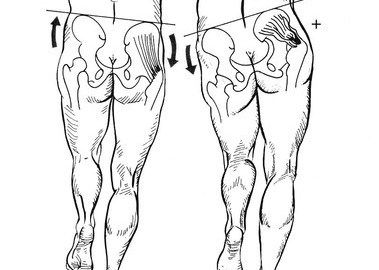A Pain in the Butt
- 11 June 2020
- Physio Form
Why is everyone talking about glutes?
It is my opinion that the glutes are the most undervalued and under-trained muscles in the body. The "glutes" are an umbrella term for 3 muscles.
- Gluteus Maximus| primary hip extender whilst walking, running or jumping.
- Gluteus Medius| hip abductors & stabiliser.
- Gluteus Minimus| hip external rotator & Stabiliser.
When considering athletic performance, most sports require some degree of triple extension. This is the simultaneous action of the hip, knee and ankle extending to propel us of the floor (Think running or jumping). As mentioned above the Gluteus Maximus is the primary hip extender and initiates this action.
In addition to power and strength during sport, the glutes also play a crucial role in posture and stability. Firstly weak glutes contribute anterior pelvic tilt, a common cause of back pain and postural dysfunction (See Image Below Left). Secondly, when balancing on a single leg during the phases of walking or running, the glutes stabilise the hip. Weak glutes can cause a trendelenberg gait (See Image Below Right), this can lead to pain in the back, hips and knees.
Our glutes become weak due to our lifestyles. 8 hour sedentary days at the office, 5 days per week, lead to limited glute activity. A muscle that doesn't get used, tends to weaken. In addition to this, long distance running, cycling and other cardio based pursuits require fairly low activity in comparison to more strenuous exercise such as hiking, lifting weights or sprinting.


Glute Pain
Glute pain with or without neurological referral into the leg is very common. However, it's notoriously difficult to treat. It can be caused by a variety of underlying pathologies but for the purpose of this article we'll focus in on three of the most frequent we see in clinic.
- Sciatica| This is caused by compression of the sciatic nerve root in the lower back. Normally through damage to a disc caused by trauma or degeneration. Despite common misconception, there isn't always associated back pain. The symptoms can present similar to Piriformis Syndrome, yet outcomes and prognosis are very different.
- Piriformis Syndrome| This is caused by tightness of the piriformis (A deep hip external rotator underneath the glutes). Tightness, weakness or inflammation of this muscle causes compression on the sciatic nerve. Which in turn leads to pain with or without numbness and tingling down the leg. 6% of people diagnosed with sciatica actually have piriformis syndrome.
- Ischial Bursitis| This is caused by prolonged sitting & muscular imbalances of the hip. The Bursa (fluid filled sack) becomes inflamed causing a point tenderness in the buttock region. It's commonly accompanied by swelling, redness and an inability to sit for prolonged periods. This condition is sometimes called "weavers bottom" or "tailor's seat".
Fix your Glutes!
Now we've learnt some of the science, let's get down to the management. Firstly, assessment by a Physiotherapist will help to formulate an accurate diagnosis. This is crucial as some of the symptoms tend to overlap between pathologies. Following on from this, a solid glute strengthening program is essential. Exercises such as split squats, hip thrusts, side planks, crab walking, clamshells and bridges all begin to correct the muscular imbalances around the hip. For examples of these exercises head to our youtube or facebook!
In addition to the foundation of exercise, massage, trigger point release, shock-wave therapy and acupuncture can also be useful adjuncts. With the end of lock-down insight, be sure to contact us for more information regarding your treatment options.

